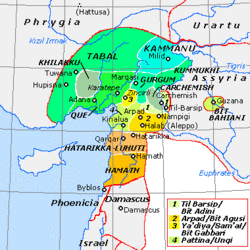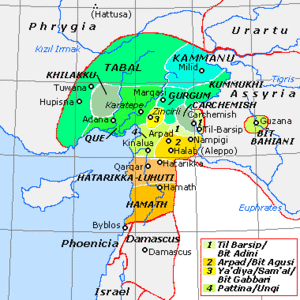Cybistra or Kybistra ( Ancient Greek: Ancient Greek: Κυβιστρα, romanized: Kubistra; Latin: Cybistra), earlier known as Ḫubišna ( Hittite: 𒄷𒁉𒅖𒈾, romanized: Ḫubišna; Old Assyrian Akkadian: 𒄷𒁉𒅖𒈾, romanized: Ḫabušna), [1] [2] was a town of ancient Cappadocia or Cilicia.
The main city of Kybistra/Ḫubišna was located at the site corresponding to present-day Karahöyük, [3] about 10km northeast of the modern town of Ereğli in Konya Province, Turkey. [4] [5] [6] [7] [8] It was the capital of a Luwian-speaking Neo-Hittite kingdom in the 1st millennium BCE.
History

Bronze Age
Ḫubišna was first mentioned in the texts of the Hittite Empire, as a country located in southern Anatolia, in the part of the Lower Land corresponding to the later Classical Tyanitis. [1]
According to the Telepinu Proclamation, Ḫubišna was one of the places which the 17th century BCE founder-king of the Hittite Old Empire, Labarna I had conquered and over which he had subsequently appointed his sons as rulers. [3]
During the 16th century BCE, the late Hittite Old Empire king Ammuna carried out several military campaigns to attempt to re-subjugate former states which had revolted against Hittite suzerainty, including Ḫubišna. [3]

Iron Age
Ḫubišna | |||||||
|---|---|---|---|---|---|---|---|
 Ḫubišna (in purple) among the
Syro-Hittite states. | |||||||
| Capital | Ḫubišna | ||||||
| Common languages | Luwian | ||||||
| Religion | Luwian religion | ||||||
| King | |||||||
•
c. 836 BCE | Puḫame | ||||||
•
c. 737 BCE | Uirimi | ||||||
| Historical era | Iron Age | ||||||
| |||||||
| Today part of | Turkey | ||||||
Kingdom of Ḫubišna
After the collapse of the Hittite Empire, Ḫubišna became one of the Syro-Hittite states of the region of Tabal, in whose southern regions it was located. [1] [3]
Little is known about the kingdom of Ḫubišna. The king Puḫame of Ḫubišna did not initially submit to the Neo-Assyrian king Shalmaneser III ( r. 859 – 824 BCE) after 24 other king of the Tabalian region submitted to him following his attack on the kingdom of Tabal proper during his campaign there in 837 or 836 BCE. Puḫame became a tributary of Shalmaneser III only after he passed through the kingdom and capital of Ḫubišna;. [9] [1] [2] [3] [10]
By c. 738 BC, the Tabalian region, including Ḫubišna, had become a tributary of the Neo-Assyrian Empire, either after the Neo-Assyrian king Tiglath-pileser III's ( r. 745 – 727 BCE) conquest of Arpad over the course of 743 to 740 BC caused the states of the Tabalian region to submit to him, or possibly as a result of a campaign of Tiglath-pileser III in Tabal. [11] [12] [7]
A later king of Ḫubišna was Uirimi, who was mentioned in the records of the Neo-Assyrian Empire as one of five kings who offered tribute to Tiglath-Pileser III in 738 and 737 BCE. [1] [2] [3]
In 679 BCE, the Assyrian king Esarhaddon ( r. 681 – 669 BCE) defeated the Cimmerians and killed their king Teušpa at Ḫubišna. Esarhaddon appears to have reached Ḫubišna by passing through the Göksu river valley and bypassing the Anti-Taurus Mountains and Tabal proper. [1] [2] [3] [13] [14] [15]
List of kings of Ḫubišna
- Puḫame ( Neo-Assyrian Akkadian: 𒁹𒁍𒄩𒈨; [16] [17] [18] r. c. 837 BCE)
- Uirimi ( Neo-Assyrian Akkadian: 𒁹𒌑𒄿𒊑𒈪; [19] [20] r. c. 740 BCE)
Classical antiquity
Strabo, after mentioning Tyana, says "that not far from it are Castabala and Cybistra, forts which are still nearer to the mountain," by which he means Taurus. [21] Cybistra and Castabala were in that division of Cappadocia which was called Cilicia. Strabo makes it six days' journey from Mazaca to the Pylae Ciliciae, through Tyana, which is about half way; then he makes it 300 stadia, or about two days' journey, from Tyana to Cybistra, which leaves about a day's journey from Cybistra to the Pylae. William Martin Leake observed, "We learn also from the Table that Cybistra was on the road from Tyana to Mazaca, and sixty-four Roman miles from the former." Ptolemy places Cybistra in Cataonia. [22]
When Cicero was proconsul of Cilicia (51/50 BCE), he led his troops southwards towards the Taurus through that part of Cappadocia which borders on Cilicia, and he encamped "on the verge of Cappadocia, not far from Taurus, at a town Cybistra, in order to defend Cilicia, and at the same time hold Cappadocia. [23] Cicero stayed five days at Cybistra, and on hearing that the Parthians were a long way off that entrance into Cappadocia, and were hanging on the borders of Cilicia, he immediately marched into Cilicia through the Pylae of the Taurus, and came to Tarsus. [24] This is quite consistent with Strabo.
Bishopric
Cybistra was from an early stage a Christian bishopric, as shown by the participation of its bishop Timotheus in the First Council of Nicaea in 325. Cyrus took part in the Council of Chalcedon in 351 and was a signatory of the letter that the bishops of the Roman province of Cappadocia Secunda, to which Cybistra belonged, sent in 458 to Byzantine Emperor Leo I the Thracian after the murder of Proterius of Alexandria. The diocese no longer appears in Notitiae Episcopatuum from the end of the 15th century. [25] [26]
No longer a residential bishopric, Cybistra is today listed by the Catholic Church as a titular see. [27]
List of titular bishops
- Nicasio Balisa y Melero, O.A.R. (14 January 1941 to 3 February 1965)
- Jacques-Antoine-Claude-Marie Boudinet (11 March 1856 to 16 June 1856)
- Philippe François Zéphirin Guillemin, M.E.P. (8 August 1856 to 5 April 1886)
- Eduard Herrmann (Hermann) (30 August 1901 to 3 March 1916)
- Johannes Baptist Katschthaler (4 June 1891 to 17 December 1900)
- Paul Nègre (7 December 1916 to 7 February 1940)
- Alexander Paterson (14 May 1816 to 30 October 1831)
- Martin Poell, O.F.M. (20 June 1890 to 2 January 1891)
References
- ^ a b c d e f Bryce 2012, p. 153.
- ^ a b c d Kessler 1975, pp. 500–501.
- ^ a b c d e f g Bryce 2009, pp. 320–321.
- ^ Richard Talbert, ed. (2000). Barrington Atlas of the Greek and Roman World. Princeton University Press. p. 66, and directory notes accompanying. ISBN 978-0-691-03169-9.
- ^ Lund University. Digital Atlas of the Roman Empire.
- ^ Weeden 2010, p. 39-40.
- ^ a b Aro 2013, p. 389.
- ^ Weeden 2017, p. 727.
- ^ Weeden 2010, p. 39.
- ^ Weeden 2023, p. 973.
- ^ Bryce 2012, p. 144.
- ^ Bryce 2012, p. 271.
- ^ Aro 2013, p. 390.
- ^ Aro 2023, p. 116.
- ^ Weeden 2023, p. 1004.
- ^ "Puhame [FOREIGN RULER] (RN)". Ancient Records of Middle Eastern Polities. Open Richly Annotated Cuneiform Corpus. Ludwig Maximilian University of Munich.
- ^ "Puhame [RULER OF HUBUšNU] (RN)". The Royal Inscriptions of the Neo-Assyrian Period. Open Richly Annotated Cuneiform Corpus. Ludwig Maximilian University of Munich.
- ^ "Puhame [RULER OF HUBUšNU] (RN)". Textual Sources of the Assyrian Empire. Open Richly Annotated Cuneiform Corpus. Ludwig Maximilian University of Munich.
- ^ "Urimmi [RULER OF QUE] (RN)". Ancient Records of Middle Eastern Polities. Open Richly Annotated Cuneiform Corpus. Ludwig Maximilian University of Munich.
- ^ "Urimmi [RULER OF QUE] (RN)". Textual Sources of the Assyrian Empire. Open Richly Annotated Cuneiform Corpus. Ludwig Maximilian University of Munich.
- ^ Strabo. Geographica. Vol. p. 537. Page numbers refer to those of Isaac Casaubon's edition.
- ^ Ptolemy. The Geography. Vol. 5.7.
- ^ Cicero, ad Fans. 15.2, 4.
- ^ Cicero, ad Att. 5.20
- ^ Michel Lequien, Oriens christianus in quatuor Patriarchatus digestus, Paris 1740, Vol. I, coll. 401-404
- ^ Raymond Janin, v. Cybistra ou Cybista, in Dictionnaire d'Histoire et de Géographie ecclésiastiques, vol. XIII, Paris 1956, coll. 1143-1144
- ^ Annuario Pontificio 2013 (Libreria Editrice Vaticana 2013 ISBN 978-88-209-9070-1), p. 869
![]() This article incorporates text from a publication now in the
public domain:
Smith, William, ed. (1854–1857). "Cybistra".
Dictionary of Greek and Roman Geography. London: John Murray.
This article incorporates text from a publication now in the
public domain:
Smith, William, ed. (1854–1857). "Cybistra".
Dictionary of Greek and Roman Geography. London: John Murray.
Sources
- Aro, Sanna (2013). "Tabal". In Streck, Michael P. [in German]; Frantz-Szabó, Gabriella; Krebernik, Manfred [in German]; Bonacossi, D. Morandi; Postgate, J. N.; Seidl, Ursula [in German]; Stol, M.; Wilhelm, Gernot [in German] (eds.). Reallexikon der Assyriologie und Vorderasiatischen Archäologie (in German). Vol. 13. Berlin, Germany; New York City, United States: Walter de Gruyter. pp. 388–391. ISBN 978-3-110-30715-3.
- Aro, Sanna (2023). "Vanishing kingdoms: Tabal and Tuwana during the seventh century BC". In Draycott, Catherine M.; Branting, Scott; Lehner, Joseph W.; Özarslan, Yasemin (eds.). From Midas to Cyrus and Other Stories: Papers on Iron Age Anatolia in Honour of Geoffrey and Françoise Summers. BIAA Monograph Series. London, United Kingdom: British Institute at Ankara. pp. 113–135. ISBN 978-1-912-09011-2.
- Bryce, Trevor (2009). The Routledge Handbook of the Peoples and Places of Ancient Western Asia: From the Early Bronze Age to the Fall of the Persian Empire. London, United Kingdom: Routledge. ISBN 978-0-415-39485-7.
- Bryce, Trevor (2012). The World of The Neo-Hittite Kingdoms: A Political and Military History. Oxford, United Kingdom: Oxford University Press. ISBN 978-0-199-21872-1.
- Kessler, K. (1975). "Ḫupišna". In Edzard, Dietz-Otto; Calmeyer, P.; Moortgat, A.; Otten, H.; Röllig, Wolfgang [in German]; v. Soden, W.; Wiseman, D. J. (eds.). Reallexikon der Assyriologie und Vorderasiatischen Archäologie (in German). Vol. 4. Berlin, Germany; New York City, United States: Walter de Gruyter. pp. 500–501. ISBN 978-3-110-06772-9.
- Weeden, Mark (2010). "Tuwati and Wasusarma: Imitating the Behaviour of Assyria". Iraq. 72. British Institute for the Study of Iraq: 39–61. doi: 10.1017/S0021088900000589. Retrieved 7 April 2024.
- Weeden, Mark (2017). "Tabal and the Limits of Assyrian Imperialism". In Heffron, Yağmur; Stone, Adam; Worthington, Martin (eds.). At the Dawn of History: Ancient Near Eastern Studies in Honour of J. N. Postgate. Vol. 2. Winona, United States: Eisenbrauns. p. 721-736. ISBN 978-1-57506-471-0.
- Weeden, Mark (2023). "The Iron Age States of Central Anatolia and Northern Syria". In Radner, Karen; Moeller, Nadine; Potts, Daniel T. (eds.). The Age of Assyria. The Oxford History of the Ancient Near East. Vol. 4. New York City, United States: Oxford University Press. pp. 912–1026. ISBN 978-0-190-68763-2.
- Tabal
- Anatolia
- Syro-Hittite states
- Former populated places in Turkey
- Geography of Konya Province
- Populated places of the Byzantine Empire
- Populated places in ancient Cappadocia
- Populated places in ancient Cilicia
- Catholic titular sees in Asia
- Ancient Cilicia geography stubs
- Byzantine Empire geography stubs
- Konya Province geography stubs
